Kent AGS Show, 2013
Without doubt the hardiest specimens in any AGS show hall are the exhibitors themselves. Despite an interminable winter the show benches were packed with an array of outstanding exhibits. As well as the heart-warming sight of more plants than at any of the earlier shows, visitors could enjoy an excellent range of artistic exhibits. Undoubtedly the highlight among these was Jean Morris’ display of needlework, which earned her a Large Gold to add to her burgeoning collection.
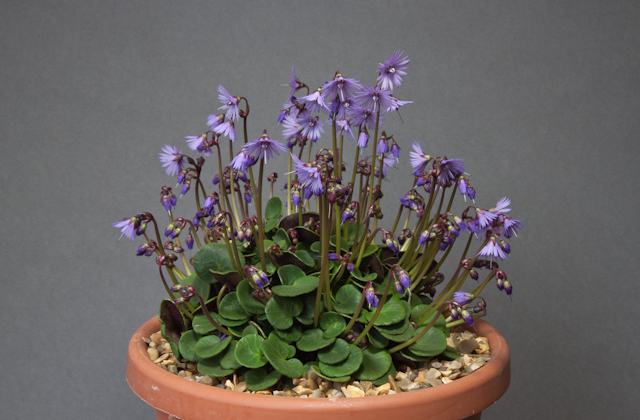
With so many superb plants on display it was a difficult (but enjoyable) task to select those few that feature in this report. One of my favourite plants on the bench (partly because of my inability to keep members of the genus alive for any length of time!) was Cecilia Coller’s Soldanella carpatica. Cecilia uses a humus-rich, acid mix and keeps the plant outdoors for most of the year, in shade at ground level on the north side of a greenhouse. This formed part of her winning six-pan class, which also contained a very striking imperial purple-coloured Iris reticulata, normally with waning flowers by the end of February, but in this exceptional year so fresh that it went to feature in a similar entry at the London Show ten days later.
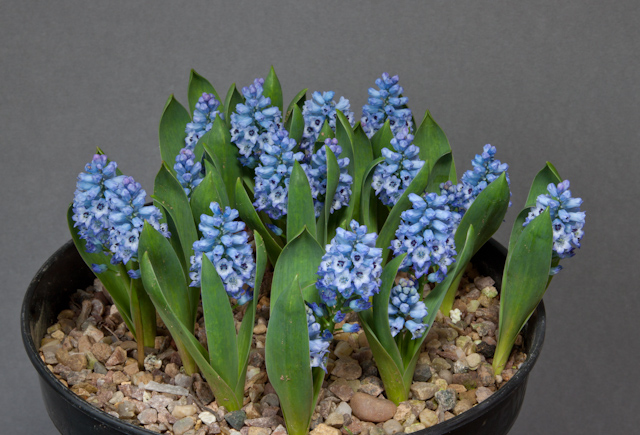
Two Certificates of Merit were awarded. The first went to a fine example of Hyacinthella pallens, a plant typically found in low altitude scrubland in former western Yugoslavia. This plant exemplifies one of the key skills of any successful exhibitor – good timing! A week earlier and the flower spikes would have been below the foliage. A week later and the lower flowers would be over. H. pallens does not increase rapidly and so it is necessary to collect the seed, which is best sown soon after it ripens.
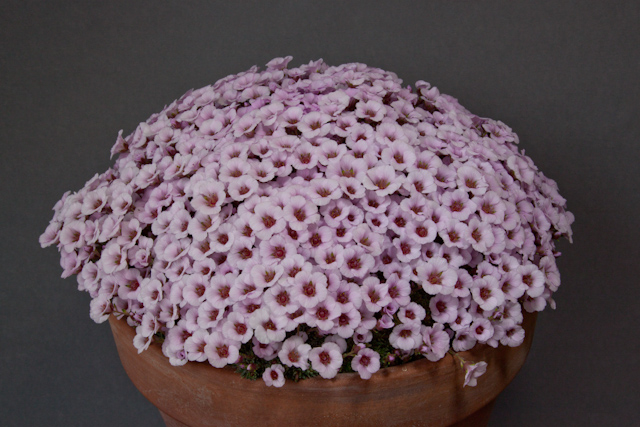
The other Certificate of Merit went to one of the largest domes of Saxifraga x irvingii ‘Jenkinsiae’ ever seen, exhibited by Alan and Janet Cook. Raised almost a century ago, it continues to perform impressively: how many of the modern hybrids will rival its performance and enduring worth?
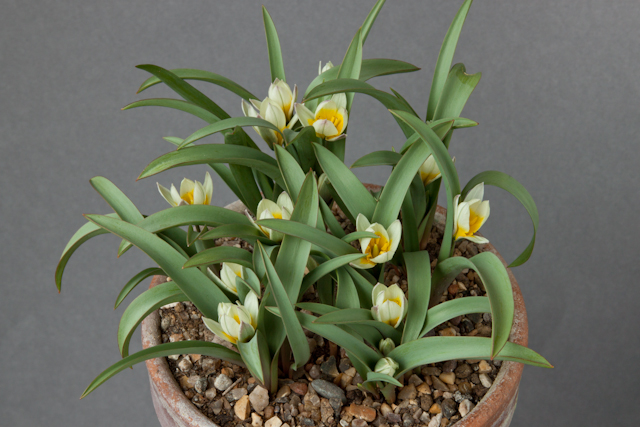
The Invicta Trophy for the Best Plant in the Novice Section was awarded to Janine Doulton’s Tulipa bifloriformis ‘Starlight’. A plant that is readily available and easy to grow, it was proof positive that it is not necessary to show the rare or unusual in order to win prizes. Janine allows the plant, and I quote, a ‘cosseted’ lifestyle, and keeps it in an unheated greenhouse all year. The potting mix consists of equal parts of J.I.3, grit and leaf-mould.
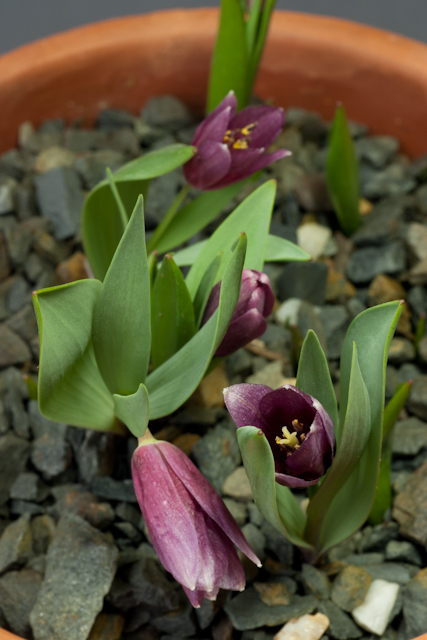
A plant for the connoisseur was Bob and Rannveig Wallis’ Fritillaria alburyana x armena, exhibited in the three-pan new or rare in cultivation class. The parents were observed growing together in acid soils at high altitudes in north-eastern Turkey, with F. alburyana preferring moister parts of the site and F. armena in drier parts. Infrequent hybrids between the plum-brown/black F. armena and the deep rose-pink (very occasionally albino) F. alburyana occur where the two meet and it is likely that back-crossing takes place as well, one result being the metallic purple example on display.
Back in their Carmarthen garden, F. alburyana x armena is grown in a mix of J.I.2 with a generous addition of grit. It is kept in the alpine house from mid-February until November, when it is moved into a fridge. As a rule it flowers two or three weeks after being removed from this shelter. Ironically (but not surprisingly) this year it was colder outside the fridge than within, hence the slightly later flowering. This was the first time in eight years the plant had flowered – well worth the wait! It has proven something of a challenge in cultivation, taking after F. alburyana rather than the relatively easier F. armena. A first in this class helped the couple on their way to the Bluebell Hill Trophy for the most points in the Open Section.
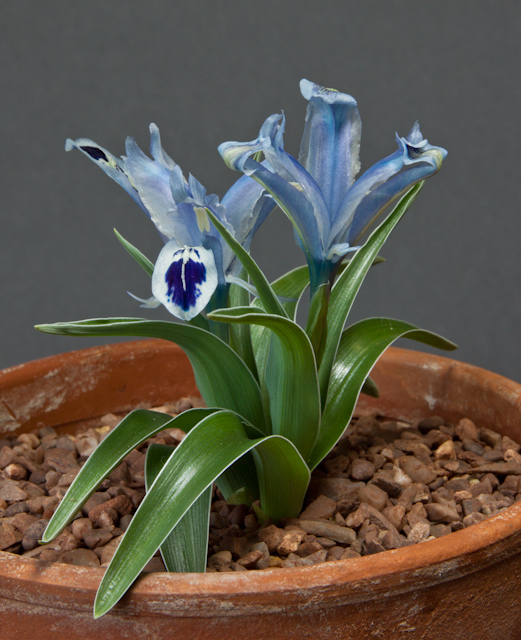
Staying with bulbs, Ruth and Alan Jones displayed an unusual Iris kuschakewiczii, which had been grown from seed originally distributed by Tim Loe. This distinguished native juno of the Tien Shan attracted all passers-by with its dark blotches on sky-blue flowers. The lower third of the pot is filled with a free-draining compost, whereupon the bulb sits on a layer of sharp sand, with the top third made up of grit alone. Careful watering in the growing season is required. The plant is fed every other time it is watered through to mid-spring and repotted in September after a dry summer rest.
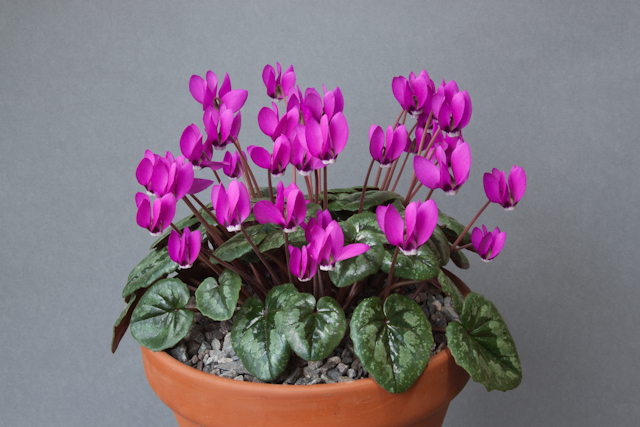
Cyclamen pseudibericum is undeniably one of the showiest members of the genus. Endemic to the wetter areas of south-eastern Turkey, it boasts some of the deepest colour forms and sweetest scents of all Cyclamen. Lee and Julie Martin’s pot was small in comparison with the much larger pans of Cyclamen that often grace AGS shows, but was (at least in my opinion) much more desirable. Like a substantial number of the genus, and indeed many alpines, C. pseudibericum often performs well in the open garden. It thrives in a sheltered semi-shaded position and often appears just as C. coum start to go over – ensuring the continued enjoyment of these fascinating plants.
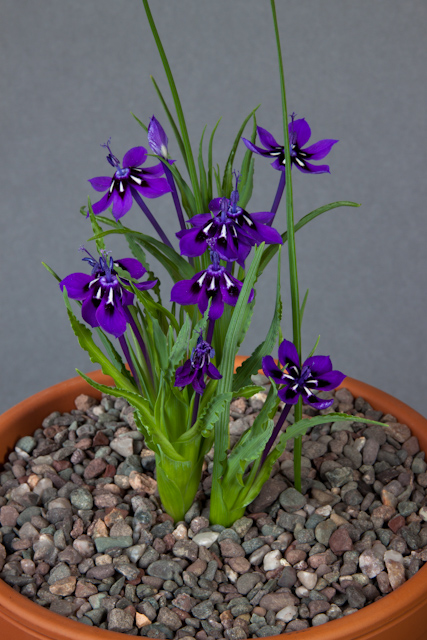
One of my favourite South African bulbs is Lapeirousia oreogena, which was exhibited by George Elder (Cardiff). There are around forty species of this component of the Iridaceae family, with this one found in the north-western Cape. George’s compost consists of equal parts J.I.2, perlite and coarse sand and it is imperative (I have found to my unfortunate cost) to keep it warm and dry during the summer. However George finds it more reliable than other Lapeirousia and it has proven capable of surviving temperatures as low as -3C.
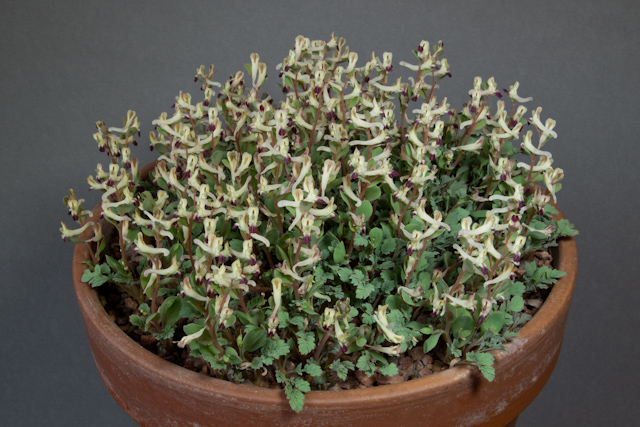
Last but definitely not least comes Corydalis darwasica, also grown by George Elder (clearly a day for Welsh success!) Found growing in the Altai Mountains, C. darwasica is perhaps not the most audaciously attractive of Corydalis, particularly when compared with C. solida varieties such as ‘Beth Evans’, but the purple tips to beige-white flowers make for a very striking display when, as here, it is grown in character. By underground deployment of an inner collar of constraining shards, George had managed to overcome the problem of the flowers coming up at the side of the pot that plagues so many Corydalis growers, in doing so producing a Farrer Medal-winning display. Another example of perfect timing – the first time the plant had produced more than six flowers coincided with a show that had delivered some fantastic plants against the odds.
Author: Robert Amos
Photographer: Jon Evans
